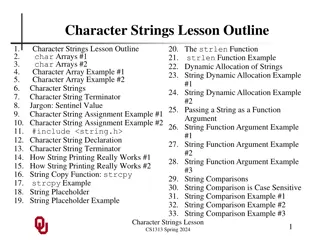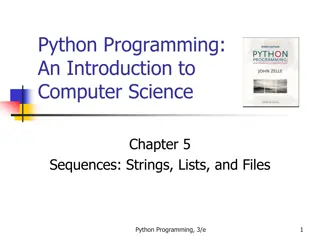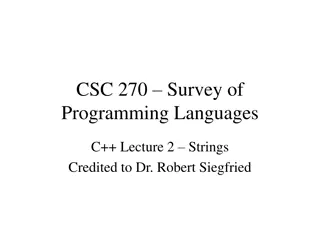Bootstrapping String Theory: Unveiling Innovations in French Strings Meeting
Delve into the exploration of bootstrapping String Theory by Eric Perlmutter at the French Strings Meeting in Annecy. The talk discusses advancements and white paper wish list aspirations in the realm of theoretical physics.
Download Presentation

Please find below an Image/Link to download the presentation.
The content on the website is provided AS IS for your information and personal use only. It may not be sold, licensed, or shared on other websites without obtaining consent from the author.If you encounter any issues during the download, it is possible that the publisher has removed the file from their server.
You are allowed to download the files provided on this website for personal or commercial use, subject to the condition that they are used lawfully. All files are the property of their respective owners.
The content on the website is provided AS IS for your information and personal use only. It may not be sold, licensed, or shared on other websites without obtaining consent from the author.
E N D
Presentation Transcript
Bootstrapping String Theory Eric Perlmutter, IPhT Saclay French Strings Meeting, Annecy May 23, 2023
My talk My talk [Yin]
Yifeis Yifei s talk talk My talk My talk Severin s talk Severin s talk [Yin]
A White Paper Wish List: Obtain the ?8?4terms in the type II string theory and M-theory effective actions. Write down the Virasoro-Shapiro amplitude for AdS5 S S5 5 . Definitively rule in/out scale-separated AdS vacua using large N conformal bootstrap. Bootstrap the worldsheet description of weakly-coupled ? = 4 super-Yang-Mills theory
This talk has three themes: String amplitudes at finite ? Exact results for ? = 4 super Yang-Mills correlators Modular symmetries in conformal field theory
We all want to solve Planar ?=4 super Yang-Mills = Classical string theory in AdS5 x S S5 5 Even just the tree-level four-graviton amplitude at finite string length would be fine This is dual to the stress-tensor four-point function in the planar theory. By the OPE decomposition, this would contain a substantial part of the solution of planar ?=4 SYM.
But this is too hard on the string side so far. Worldsheet: RR flux Spacetime: action unknown o In flat space, unknown beyond ?6?4. o In AdS, even more complicated. Looking for a handle The large N conformal bootstrap can determine string effective actions: 1 Bootstrap CFT correlator 2 Interpret as AdS amplitude (+ flat space limit if desired)
But this is too hard on the string side so far. Worldsheet: RR flux Spacetime: action unknown o In flat space, unknown beyond ?6?4. o In AdS, even more complicated. Looking for a handle The large N conformal bootstrap can determine string effective actions: 1 Bootstrap CFT correlator I know. What s new? 2 Interpret as AdS amplitude (+ flat space limit if desired)
Most work in this vein has been in a low-energy expansion. We want to do better. Localization leads to exact results for SUSY quantities. Sometimes, these quantities are independent of the coupling (partition functions, SUSY indices) But not always. e.g. 4d ?=2 SQCD extremal 2-pt functions. What about in ?=4 SYM?
Consider ? = 4 super Yang-Mills, with gauge group G. It contains a complexified gauge coupling on which generic observables depend. Being exactly marginal, ?parameterizes a conformal manifold preserving ? = 4 SUSY: Free SYM A CFT at every point
All single-trace operators are -BPS or unprotected. Unprotected correlators are too hard. 2-, 3-point functions of -BPS operators are independent of coupling. 4-point functions depend on cross-ratios and receive unprotected contributions Remarkably, there is a class of integrated 4 localization, even at finite N. integrated 4-point functions which can be computed exactly from Combined with large N bootstrap methods, these teach us about string effective actions. They are also amazing observables in their own right.
There is another thing: ? = 4 SYM enjoys S S- -duality duality. For simply-laced G, this is a self-duality under SL(2, ) transformations of ?(up to global identifications). e.g. (Non-local observables invariant under congruence subgroups.) S-duality of ? = 4 SYM is beyond a reasonable doubt Field theory (D-instantons, 1/N, bound states, partition functions, ) Holography + string theory (D-instantons, graviton scattering, ) But its abstract consequences for CFT observables have not been fully understood. [Montonen, Olive; Olive, Witten; Osborn; Argyres, Kapustin, Seiberg; Vafa, Witten; Sen; Gomis, Okuda; Dorey, Hollowood, Khoze, Mattis, Vandoren; Green, Gutperle; Banks, Green; Green, Miller, Vanhove; D Hoker et al; Beem, Rastelli, Sen, van Rees; Chester, Green, Pufu, Wang, Wen; ]
This is just one instantiation of SL(2,) invariance: In conformal field theory, modularity is everywhere. Spacetime symmetry of 2d CFT Electric-magnetic duality symmetry of Maxwell theory Generalized modularity of counting functions in superconformal field theories Everybody knows that we should first process symmetries, then compute. Why can t we do this for modular invariance?
This is just one instantiation of SL(2,) invariance: In conformal field theory, modularity is everywhere. Spacetime symmetry of 2d CFT Electric-magnetic duality symmetry of Maxwell theory Generalized modularity of counting functions in superconformal field theories Everybody knows that we should first process symmetries, then compute. Why can t we do this for modular invariance? (We can.)
The rest of the talk is a story about these intertwined concepts, and how they are leading us toward exact (quantum) string theory observables. Outline: Outline: 1) String tree amplitudes 2) from N=4 SYM correlators Unintegrated Integrated 3) SL(2, ) spectral theory Application to Integrated correlators & semiclassical string theory
Some relevant things that I wont/cant talk about: Modular structure of string worldsheet integrands AdS Unitarity Method/Loop amplitudes Integrability String Field Theory methods Ensemble averages and gravity
String tree amplitudes and holography Quartic supergraviton scattering amplitudes in (say) type IIB string theory in flat space take the form There is a corresponding effective action: In type IIB string theory, these are SL(2, )-invariant functions, order-by-order. (In type IIA, only dilaton) Higher orders are not fully known.
String tree amplitudes and holography Here are the ones that we know (cf. explicit worldsheet/S-duality/on-shell methods): You re probably familiar with non-holomorphic Eisenstein series, eigenfunctions of hyperbolic Laplacian: Note the Maass cusp forms, also eigenfunctions (more later) Less familiar are the generalized Eisensteins Higher-order terms, ?8?4 and beyond, are unknown in general (modulo low-loop perturbative data) [Kleinschmidt, Dorigoni, Schlotterer; Klinger- Logan; Klinger-Logan, Miller, Radchenko; Chester, Green, Pufu, Wang, Wen] [Green, Gutperle; Green, Gutperle, Kwon; D Hoker, Green, Vanhove; Green, Russo, Vanhove; Green, Miller, Vanhove; Wang, Yin; ]
String tree amplitudes and holography What about AdS? It s easy to understand why the AdS string effective action is more complicated... (Put two legs on S5) Finite Finite- -size correction size correction
String tree amplitudes and holography What about AdS? It s easy to understand why the AdS string effective action is more complicated... At fixed order in ? , amplitudes are not homogeneous in momenta At fixed order in momenta, coefficients have an infinite expansion in ?
String tree amplitudes and holography but the AdS effective action is of clear interest: 1) It encodes CFT correlators [Polchinski; Penedones] 2) It can be derived from CFT correlators [Maldacena, Simmons- Duffin, Zhiboedov] [Komatsu, Paulos, van Rees, Zhao] One can also take the flat space limit. This isolates the leading term in momenta, order-by-order in ? .
String tree amplitudes and holography Implementing this program, can be recovered from certain computations of ?=4 SYM four-point functions. The holographic results also determine an infinite set of SUSY-protected terms at higher-orders. We now turn to how this works. (N.B: Analogous results exist in M-theory.)
?=4 SYM correlators Define -BPS superconformal primaries Holographically dual to scalar KK modes on S5 (modulo multi-trace admixture details) At p>2, there is degeneracy (multi-traces), e.g. Dual to -BPS gas of gravitons Consider four-point functions: schematically, = SC Ward identity factor Specialize (for now) to simplest case of p=2 Four-point supergraviton amplitude in AdS5
?=4 SYM correlators: Finite N Some is known about <22pp> at finite N Perturbation theory o Two loops (generic p) o Three loops (p=2) [D Alessandro, Genovese] [Drummond, Duhr, Eden, Heslop, Pennington, Smirnov; Eden, Heslop, Korchemsky, Sokatchev; Fleury, Pereira] Numerical superconformal bootstrap o Mainly p = 2 o Some p = 2, 3 (mixed correlator system) [Beem, Rastelli, van Rees; Bissi, Manenti, Vichi; Alday, Chester; Chester, Dempsey, Pufu]
?=4 SYM correlators: Large N At large N, the usual t Hooft limit is well-studied: Perturbation theory in ? 1(Feynman diagrams, symbology, etc), ? 1(holography) Integrability Planar numerical conformal bootstrap [Caron-Huot, Coronado, Trinh, Zahraee] Less familiar is the very strongly coupled limit: This preserves SL(2, ) properties of SYM observables. [Azeyanagi, Hanada, Honda, Matsuo, Shiba] In particular, <22pp> is SL(2, )-invariant.
Semiclassical AdS5 x S5 string amplitudes In the t Hooft limit, bulk string theory is weakly coupled. The tree-level four-graviton string amplitude is the AdS5 x S S5 5 -Virasoro-Shapiro amplitude Various partial results here Recent bootstrap + Integrability approach: [Alday, Hansen, Silva] (Dispersive sum rules) + (Integrability data) + (svMZV assumption) All Nice structural generalization of VS amplitude with complicated details (Instead expand in momenta?)
Semiclassical AdS5 x S5 string amplitudes We henceforth focus on the very strongly coupled limit, where SL(2, ) is manifest. The <2222> correlator has been computed to several orders in 1/N. In Mellin space, Supergravity Orange = Finite-size corrections The supergravity term has been bootstrapped from CFT: Ward IDs + holographic consistency conditions [Rastelli, Zhou] Indeed, <p1 p2 p3 p4> supergravity correlators follow from a single master formula: Hidden 10d conformal sym [Caron-Huot, Trinh] Corrections to supergravity have been reproduced from CFT by different, more involved means .
Semiclassical AdS5 x S5 string amplitudes Consider the first correction (?4): Constructed in late 90 s via instantons + string duality [Gutperle, Green] Required by on-shell superamplitude identities (Laplace eq with ? = 3/4) [Wang, Yin] What about S-matrix bootstrap approach: In the space of consistent S-matrices, Where is String Theory? [Guerrieri, Penedones, Vieira] with? = ? + ??
Semiclassical AdS5 x S5 string amplitudes Consider the first correction (?4): Constructed in late 90 s via instantons + string duality [Gutperle, Green] Required by on-shell superamplitude identities (Laplace eq with ? = 3/4) [Wang, Yin] What about S-matrix bootstrap approach: In the space of consistent S-matrices, Where is String Theory? [Guerrieri, Penedones, Vieira] with? = ? + ?? Maximized at cusp, ? Minimized at corner, with near-extremal value!
Semiclassical AdS5 x S5 string amplitudes from CFT Let us now delve into how the corrections were computed from the CFT. As a segue, recall the earlier result of [Chester-Dempsey-Pufu] Q: Q: How did they track position along ? A: A: By using certain exact quantities integrated correlators obtained from localization. Remarkably, <22pp> correlators may be found exactly, for all ?,? and ?(!) IF IF we integrate against a specific spacetime measure.
?=4 SYM Integrated Correlators Mass-deformed free energy on S4 with ?? source Here is the basic relation: Brings down two ?? s Brings down two ?2 s Specific measure [Binder, Chester, Pufu, Wang; Chester, Pufu]
?=4 SYM Integrated Correlators Mass-deformed free energy on S4 with ?? source Here is the basic relation: Brings down two ?? s Brings down two ?2 s Specific measure This is tremendously powerful. In the planar limit, e.g., Other derivatives are possible: [Binder, Chester, Pufu, Wang; Chester, Pufu]
?=4 SYM Integrated Correlators: Large N With this in hand, the p=2 case was systematically studied in the very strongly coupled limit. Combining various constraints + flat space limit yielded the previous unintegrated formula. (Idea: integrate general amplitude and match.) ~ No protection beyond ?6?4 At higher-orders, can only get SUSY *part* of the correction: not enough localization constraints But, here s a new thing: Generalized Eisensteins appear to all orders in the AdS5 and ?10 string effective actions. [Chester, Green, Pufu, Wang, Wen]
?=4 SYM Integrated Correlators: Finite N What about finite N? A solution may be inferred from SUSY localization, for all ?,? and ?! This was pioneered by [Dorigoni, Green, Wen], who conjectured/computed this for p=2: Rational function involving Jacobi polynomials, e.g. N>2 recursively defined by Laplace difference equation : This recursion was later proven by [Dorigoni, Green, Wen, Xie] directly from the matrix model, with N=2 as an initial condition.
?=4 SYM Integrated Correlators: Finite N The DGW result is manifestly SL(2, )-invariant. There is another SL(2, )-invariant presentation of this object, which arose from some parallel developments in the broader CFT literature.
?=4 SYM Integrated Correlators: Finite N The DGW result is manifestly SL(2, )-invariant. There is another SL(2, )-invariant presentation of this object, which arose from some parallel developments in the broader CFT literature. How do we better understand modularity in CFT? Use SL(2, ) spectral theory = Harmonic analysis on the fundamental domain Applying to the integrated correlators leads to great simplifications, and makes physical features transparent.
SL(2,) Spectral Theory A square-integrable, SL(2, )-invariant function admits a unique decomposition into an SL(2, )- invariant complete eigenbasis of the hyperbolic Laplacian. [See e.g. Terras]
SL(2,) Spectral Theory A square-integrable, SL(2, )-invariant function admits a unique decomposition into an SL(2, )- invariant complete eigenbasis of the hyperbolic Laplacian. 1. Constant: Modular average 2. Continuous: Eisenstein series 3. Discrete: Maass cusp forms Chaotic Smooth
SL(2,) Spectral Theory A square-integrable, SL(2, )-invariant function admits a unique decomposition into an SL(2, )- invariant complete eigenbasis of the hyperbolic Laplacian. 1. Constant: Modular average 2. Continuous: Eisenstein series 3. Discrete: Maass cusp forms Chaotic Smooth
SL(2,) Spectral Theory A square-integrable, SL(2, )-invariant function admits a unique decomposition into an SL(2, )- invariant complete eigenbasis of the hyperbolic Laplacian. 1. Constant: Modular average 2. Continuous: Eisenstein series 3. Discrete: Maass cusp forms
SL(2,) Spectral Theory A square-integrable, SL(2, )-invariant function admits a unique decomposition into an SL(2, )- invariant complete eigenbasis of the hyperbolic Laplacian. 1. 1. Constant Constant: : Modular average Modular average 2. Continuous: Eisenstein series 3. Discrete: Maass cusp forms
SL(2,) Spectral Theory A square-integrable, SL(2, )-invariant function admits a unique decomposition into an SL(2, )- invariant complete eigenbasis of the hyperbolic Laplacian. 1. Constant: Modular average 2. 2. Continuous Continuous: : Eisenstein series Eisenstein series 3. Discrete: Maass cusp forms Fourier decomposition: Functional equations: Completed Riemann zeta Overlap is a Mellin integral of zero mode zero mode: [Rankin, Selberg]
SL(2,) Spectral Theory A square-integrable, SL(2, )-invariant function admits a unique decomposition into an SL(2, )- invariant complete eigenbasis of the hyperbolic Laplacian. 1. Constant: Modular average 2. Continuous: Eisenstein series 3. 3. Discrete Discrete: : Maass Maass cusp forms cusp forms Maass cusp forms are the most interesting eigenfunctions. Functionally similar to Eisenstein series but they vanish at the cusp and are infinite in number, but none o Small n: numerics (~103 digits) none known analytically [Hejhal; Then; Booker, Strombergsson, Venkatesh; Sarnak; ] o Large n: universality
SL(2,) Spectral Theory Why are the cusp forms so elusive? They are chaotic. ( Arithmetic chaos , not RMT.) Leads to sporadic behavior and large n universality.
SL(2,) Spectral Theory Spectral parameter ? 125.347558 Spectral parameter ? 500.283548 Why are the cusp forms so elusive? They are chaotic chaotic. ( Arithmetic chaos , not RMT.) Leads to sporadic behavior and large n universality. [Hejhal, Rackner; Then]
SL(2,) Spectral Theory Spectral parameter ? 125.347558 Spectral parameter ? 500.283548 Why are the cusp forms so elusive? They are chaotic. ( Arithmetic chaos , not RMT.) Leads to sporadic sporadic behavior and large n universality. [Hejhal, Rackner; Then]
SL(2,) Spectral Theory Spectral parameter ? 125.347558 Spectral parameter ? 500.283548 Why are the cusp forms so elusive? They are chaotic. ( Arithmetic chaos , not RMT.) Leads to sporadic behavior and large n universality universality. Random Wave Conjecture Gaussian Moments Conjecture [Sarnak et al; ] Quantum Unique Ergodicity Ramanujan Conjecture Understanding this chaos in CFT: still in progress! [Hejhal, Rackner; Then]
Spectral Decomposition in CFT The power of modularity is its ability to relate UV data to IR data. In 2d CFT, SL(2, ) relates low-E and high-E spectral densities (Cardy formula) Normally, modularity of Z(?) is obscured while character expansion is manifest. The spectral decomposition reverses this. [Benjamin, Collier, Fitzpatrick, Maloney, EP] Beware: Z(?) is not square-integrable. Apply with care! U(1)c Narain CFT Virasoro CFT [Benjamin, Chang; Haehl, Marteau, Reeves, Rozali; Benjamin, Collier, Kruthoff, Verlinde, Zhang; Di Ubaldo, EP] Interesting connections to random matrix statistics and wormholes in AdS3 gravity. Many further CFT applications await [Luo, Wang]























